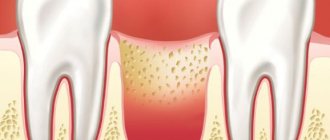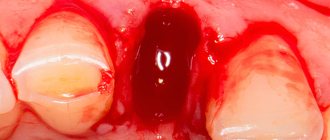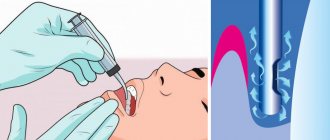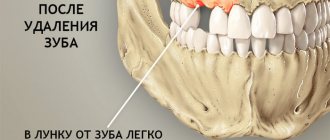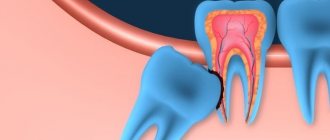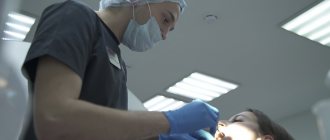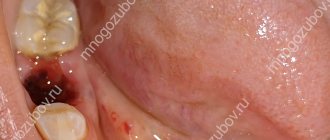Extracting the root of a badly damaged or broken tooth is one of the most time-consuming, painstaking and unpleasant dental procedures, requiring all the skill and knowledge of the surgeon. This is due to the fact that the roots of some teeth have a very complex anatomical structure, and their fragments can remain inside the gums. The dental surgeons at Dr. Granov’s clinic take their work very seriously and have extensive experience in successfully performing such operations. The root of a tooth may remain in the gum as a result of unsuccessful tooth extraction or injury. Usually in such cases, our patients are bothered by the sensation of a foreign object in the gum or pain in neighboring teeth. In addition, root fragments are clearly visible on an x-ray.
How a tooth root is removed in our clinic
A mandatory step in this procedure is the administration of local anesthesia. Typically, the pain relief lasts for several hours, and you will not experience any discomfort during the removal. After removal, a course of antibiotics is usually prescribed. As for the root removal process itself, the surgeon’s actions and the choice of instrument largely depend on the following circumstances:
- how deep is the root of the tooth;
- where the tooth is located: on the upper or lower jaw;
- are there pathological changes in the tissues around it, etc.
Indications for care after removal of the upper tooth
- After removing a front tooth or root tooth, the doctor places a gauze swab into the hole, the purpose of which is to create compression and block small capillaries. This is necessary to stop bleeding. You can keep the tampon in your mouth for no more than half an hour. If it remains in the hole longer, the wound may become infected.
- The blood clot (thrombus) that forms in the hole should not be touched with the tongue, toothpick, hands, or try to rinse it out of the mouth. The blood clot protects the wound from penetration of microbes and promotes its healing.
- For two to three hours after the removal of the upper teeth, you should not eat or drink, so as not to infect the socket. Within three hours, the blood clot will be completely formed, then the likelihood of food getting into the hole will be negligible.
- For several days after surgery, you should refrain from spicy foods and hot drinks.
- On the day of removal of the upper tooth, it is not recommended to perform any hygienic manipulations in the oral cavity. You can brush your teeth the next morning, but avoid the surgical area. In the future, you can return to normal dental care.
We also advise you to read the article about the removal of upper wisdom teeth
Removing a tooth root using forceps
First, the doctor separates the periodontal tissue from the root so that the exposed part of the root can be easily grabbed with forceps. If this is difficult to do, the doctor separates the periosteum and the edge of the mucosa from the socket. It is much more difficult to remove upper teeth than lower teeth, so bayonet-shaped and S-shaped forceps are used for this. The doctor places the instrument as tightly as possible and makes rotational movements with it. If the tissues surrounding the tooth are affected by an inflammatory process, then the problematic root can be extracted quite quickly. The most difficult teeth in this regard are the canines and lower molars, since they have large alveolar processes.
Factors determining the choice of tooth extraction technique:
- condition of the tooth (degree and nature of destruction of hard dental tissues);
- features of the anatomical structure and position of the tooth, taking into account its group affiliation;
- features of the anatomical structure of the dentoalveolar segment in the area of the tooth being removed;
- The condition of the marginal periodontium is the degree of tooth mobility.
The operation of tooth extraction is the most common in the outpatient practice of a dental surgeon. Like any surgical intervention, tooth extraction surgery may be accompanied by complications that arise during the operation:
- Fracture of the tooth or root being removed. It can be associated both with significant tooth destruction and with structural features of the root or surrounding bone tissue.
- Fracture, dislocation and removal of an adjacent tooth occur as a result of using forceps with wider cheeks than the crown of the tooth being removed, or when elevators are used incorrectly, when the elevator rests on the adjacent tooth.
- Damage to the crown of the antagonist tooth occurs when the forceps slip off the tooth being removed.
- Pushing the root into the soft tissue is possible when removing the third lower molar in case of insufficient fixation with the fingers of the left hand.
- Fracture of the mandible is rare. The development of this complication is facilitated by pathological processes in the body of the lower jaw, which reduce its strength (odontogenic osteomyelitis, benign and malignant tumors.)
- Fracture of a section of the alveolar process. May be as a result of a pathological process in the periodontium.
- A fracture of the tubercle of the upper jaw can occur when the upper 8th tooth is removed.
- Dislocation of the lower jaw can occur when the mouth is opened wide and strong pressure is applied to the lower jaw with forceps or an elevator.
- Damage to soft tissue as a result of instrument slipping.
- Perforation of the bottom of the maxillary sinus can be a result of individual structural features of the upper jaw or due to previous pathological processes in the area of the apex of the tooth root.
- Aspiration of teeth and small instruments. This is facilitated by a decrease in the gag reflex after anesthesia and the position of the patient in a chair with his head thrown back.
Early postoperative complications may also occur. This type of complications includes:
- bleeding, which may be the result of a mechanical injury or a consequence of arterial hypertension or diseases accompanied by dysfunction of the body’s coagulation system;
- alveolar (socket) pain that appears after the cessation of anesthesia in the area of the extracted tooth. This is a natural response to tissue injury;
- alveolitis – a purulent infectious-inflammatory process in the periodontium of an extracted tooth;
- osteomyelitis;
- neuritis of the inferior alveolar nerve.
Tooth root removal using an elevator
In cases where the tooth root is located very deep and is difficult to reach with forceps, an elevator is used to remove it. The doctor inserts this instrument into the narrow gap between the edge of the hole and the root, and then rotates it while simultaneously pressing lightly. With these movements, the periodontal ligaments holding the root are torn. Using the elevator as a kind of lever, the doctor seems to push the root out of the hole. Even if it does not come out of the gum completely, the exposed part is enough to pull it out with forceps.
How long does it take to remove a front tooth?
The time it takes to remove the upper teeth can vary from a few minutes to an hour. On average, the operation takes 15-20 minutes. Much here depends on the initial situation and the qualifications of the dentist.
Removing front teeth is usually simple. Some difficulties may arise when extracting the upper canine, since it has a long, massive root with an often curved apex.
During surgery to remove a front tooth, the patient sits in a chair with a slightly reclined back and headrest. The doctor is in front of the patient on the right. The procedure looks like this:
- the gum is separated from the edge of the alveolus, and the circular ligament is separated from the neck;
- the forceps are applied to the tooth, moved under the gum and fixed;
- the dentist rocks or rotates the tooth to break the fibers connecting the root to the walls of the socket;
- the front tooth is removed from the socket;
- The surgical site is inspected and broken root fragments are removed from the socket.
The nuances of wisdom tooth root removal
In most cases, wisdom teeth are formed incorrectly and grow at an angle, so their roots are often located perpendicular to the roots of neighboring teeth and have a complex shape. Serious problems can arise even before the “eights” fully erupt. Removal of the roots of wisdom teeth occurs under regular x-ray control, especially if their coronal part is destroyed. Only a very experienced doctor can correctly extract the roots, otherwise irreparable harm can be caused to the roots of healthy neighboring teeth.
Causes of complications during tooth extraction
Among the main reasons for the development of complications after tooth extraction are:
- Anatomical features of the jaw structure. Among the main ones are long thin roots near the tooth, a high level of curvature of dental roots, thick alveolar walls and dense partitions between the roots.
- Little experience and carelessness of the dentist. Incorrect selection and illiterate use of tools leads to fractures of the tooth roots or the crown itself. Also, with an unprofessional operation, the risk of gum injury and soft tissue damage due to slipping of the forceps increases.
- Lack of X-ray control after complex removal. The doctor does not notice the root or fragment of a tooth left in the hole, which leads to the development of inflammation.
- Ignoring doctor's recommendations. Poor oral hygiene, intensive rinsing, alcohol, smoking, visiting a bath or excessive exercise cause various complications that require long-term treatment.
To reduce the risk of unpleasant symptoms after removal, it is enough to choose an experienced surgeon, a proven dental clinic with its own X-ray room and good equipment, and follow all the specialist’s recommendations. This approach guarantees a high chance of rapid healing and helps to avoid studying photos of complications after tooth extraction and treatment of pathologies. Also, a good dental surgeon will remind you of the need for prosthetics or implantation, and talk about the importance of maintaining the integrity of the dentofacial rows.
Is it necessary to remove tooth roots?
The issue of tooth root removal can only be decided by your attending dentist based on the examination and the X-ray obtained. If it is not a source of infection and the tissues surrounding it are healthy, then the root can be used in the future as a support for an artificial crown, having previously “extended” it using a stump tab. Tooth root extraction is highly recommended in the following situations:
- a cyst has formed on the root of the tooth;
- the tooth was severely damaged by caries;
- root fracture;
- one of the walls of the tooth has broken off, and the chip goes deep into the gums;
- There is severe tooth mobility caused by periodontal diseases.
Difficult removal
When removal is considered difficult:
- if there are impacted “eights” (unerupted wisdom teeth);
- dystopic “eights” (incorrectly positioned);
- multi-rooted molars;
- the root is severely bent or damaged;
- fusion of bone tissue with the tooth root;
- the presence of a cyst or fistula.
Typically, complex removals require more time.
What is the difference between a simple and complex removal procedure?
Simple deletion is considered in the following cases:
- movable tooth;
- single-rooted or double-rooted tooth;
- baby tooth.
The easiest way is to remove a mobile baby tooth. Sometimes it is performed without anesthesia and goes unnoticed by the patient.
As mentioned above, complex procedures most often include the removal of wisdom teeth. “Eights” quite often do not erupt completely or grow incorrectly. Therefore, many people, when a third molar appears, try to delay a visit to the dentist, dampen the discomfort with painkillers and postpone treatment “for later.”
It is best to immediately, when the “eight” appears, come for an examination to a dentist, who, having seen any deviations, will be able to immediately remove the tooth.
The most frequently asked questions from our patients
What happens if the tooth root is left in the gum?
If the root of the tooth is left as is, it becomes a source of infection, and after some time serious complications may develop, for example:
- inflammation of the tissues surrounding the tooth, including bone;
- penetration of infection into the wound surface;
- periodontal disease.
What is a root canal and can it be treated rather than removed?
The root (or dental) canal is an anatomical space inside the root of a tooth filled with pulp. Cleaning and treatment of dental canals is a mandatory stage of dental fillings and prosthetics. In our clinic, for this purpose, we use self-adapting files of the SAF system, which carefully clean the canals from dead and diseased tissue, pus, and accumulations of bacteria, without injuring healthy areas of the tooth. Thanks to their hollow structure, the doctor can simultaneously treat the root canal with disinfectants and anti-inflammatory drugs. Root canals are preserved only if the tissues surrounding the tooth are not affected by pathological processes, and in the future the root can be used for prosthetics.
If the tooth can still be restored, root canal treatment (roots) of the tooth is performed. It can be successfully completed in our Moscow clinic.
Complication after tooth extraction: treatment
Any hint of a complication is a signal for the patient to visit a doctor. Most pathologies in the initial stage are treated quickly and easily:
- Treatment of alveolitis - removal of a foreign object from the socket, antiseptic treatment, application of medication. When a purulent focus forms, the doctor will open the formation and clean the wound. Treatment may also involve prescribing medications and physiotherapeutic procedures.
- Damage to the facial nerve usually goes away on its own, but sometimes the recovery process is accelerated by prescribing vitamins and injection therapy.
- Residual tissue in the hole must be removed, after which the wound is cleaned of pus, washed and stitched to speed up recovery.
- Chips and damage to adjacent teeth are treated according to the amount of damage caused. This can be a simple filling or full prosthetics.
- Fracture - treated by repositioning the bones and fixing them with splints or synthesis of bone tissue in the area of damage.
- Purulent inflammations are eliminated quite simply. At the dental clinic, the patient is exposed to the source of inflammation and appropriate therapy is prescribed.
Complications and consequences
The most common complication of tooth extraction is root/crown fracture. If the adjacent unit is fragile, caries-affected, and mobile, it may dislocate or fracture. Damage to the mucous membranes is observed in case of gross violations of technique, injury to the tongue/hard palate - when the instrument slips.
Complications and consequences
:
- bleeding
_ Traumatic intervention is always accompanied by bleeding - after 3-4 minutes, after blood clotting in the hole, it stops. Early secondary bleeding can develop due to the action of adrenaline, which was used for pain relief, later secondary bleeding - due to the occurrence of inflammation in the wound; - postoperative pain
. The severity of the syndrome is determined by the nature of the injury, the discomfort goes away after 12-24 hours. If the pain does not go away after taking analgesics, the reason may be the development of alveolitis, osteomyelitis of the socket; - alveolitis
. Progresses against the background of infection in the bed of the removed unit in the presence of chronic/acute periodontitis, a decrease in the body's immune response. Symptoms: aching pain radiating to the temple (ear), temperature fluctuations, general weakness, swelling of the face; - hematoma
_ It is formed in the gum tissue as a result of high blood pressure and increased capillary fragility. Causes swelling, redness, fever - requires anti-inflammatory drug therapy; - paresthesia
. Decreased sensitivity of the cheeks, corners of the mouth, chin, and lips provoke disturbances in the functioning of the central nervous system. Recovery on average takes 12-16 days, less often - 28-30 days. If there is no improvement, you should consult a doctor and undergo courses of medication and physiotherapy to eliminate inflammation.
The recovery period takes on average 4-6 days. During healing, painful sensations in the oral cavity, increased body temperature, and swelling of the cheek are observed - this is normal. If purulent discharge appears in the bed of the socket, intense pain, bad breath, the temperature rises to 39-40 degrees. These symptoms indicate the addition of an infection, which can result in damage to the internal organs/systems of the body. If such a situation occurs, it is necessary to urgently visit a doctor to eliminate serious complications.
Indications
- impacted wisdom teeth. Retention is a delay in the eruption of a formed tooth due to lack of space in the row, pathology of the mucous membrane, diseases that inhibit the development of the skeletal system and prevent the tooth from erupting (tumors, local inflammation, jaw injuries). Difficult eruption of the “eighth” units provokes dangerous complications - phlegmon, abscess, pericoronitis;
- dystopic third molars on the upper/lower jaw. Anomalies in the position of the organ lead to damage to neighboring chewing units, crowding of row units, and the development of inflammatory processes;
- significant destruction/curvature of the root segment without the possibility of restoration;
- fusion of roots with bone tissue;
- presence of follicular cyst/fistula tracts on the anterior or lateral units.
Methods of complex tooth extraction
are divided according to the degree of impact (fragmentation of residues, alternate extraction of elements or extraction of residues completely), depending on the level of destruction of the walls of the hole.
Prices for complex removal of teeth of the upper and lower jaw
Tooth extraction is a difficult operation that requires special knowledge and skills from the surgeon. Our clinic employs experienced specialists who use modern anesthesia, the latest technologies and professional equipment, so the manipulations are performed efficiently and as painlessly as possible. The price for the service in Moscow varies between 5,000-8,000 rubles.
To find out the cost of complex tooth extraction, book a consultation at our clinic in Moscow by calling: 8 (495) 380-01-38.
| Code no. | Name of procedures | Unit of measurement | Cost, rub. |
| 601 | Application anesthesia | 150,00 | |
| 602 | Infiltration anesthesia, conduction | 550,00 | |
| 605 | Removal is difficult | 1 tooth | 3 500,00 |
* The prices indicated on the website are not a public offer. The exact cost of treatment can only be determined at an appointment with a doctor.
Prices for treatment in Moscow full price list
Share on social media networks:
Article Expert:
Lavrentyev Sergey Sergeevich
Doctor - dentist, surgeon, implantologist. He regularly improves his professional level and studies modern methods of dental implantation and surgical dentistry at international seminars and conferences of outstanding implant surgeons in the world.
Work experience 25 years
Preparation
Before the procedure, the doctor conducts a consultation, a detailed examination and an x-ray of the tooth to be extracted: the degree of damage to the dental crown and the presence of anomalies are revealed. Based on the diagnostic results and radiographs, a clinical picture is formed, the number, size, shape of the roots, their relationship with the mandibular canal and maxillary sinus, and the size of bone resorption are established.
When removing 8 units, be sure to take into account its position, the width of the retromolar space, and the depth of immersion. Based on these data, the doctor draws up a surgical procedure and selects surgical instruments.
If the patient has an inflammatory focus in the periodontium, antibiotics are prescribed 24 hours before the planned surgery. Patients who are terrified of the dental chair are given sedative preparation.
Stages of the surgical procedure
Before the procedure, a consultation is carried out and the necessary X-ray diagnostics are prescribed.
After which the doctor begins the actual removal:
- First, an anesthetic is injected.
- If the eighth tooth has not fully erupted, a small incision is made in the gum to access it.
- After this, the tooth is removed using an elevator.
- The gum is sutured.
If the tooth is completely under the bone, a larger incision is made in the gum, and in order to extract the dental unit, it is cut into several parts.
Removing a cyst is a highly complex procedure. The mucous membrane is cut, bone tissue is removed with special burs, after which the cyst is removed. Next, in order to avoid relapse, the root tip is removed.
